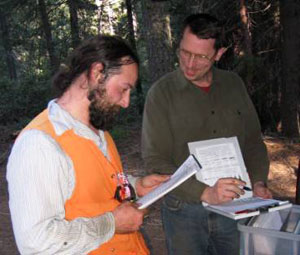 |
|||
| Forest Resources Home | News | Make a Gift | |||
|
September 2009 | Return to issue home
Recent Discoveries... Investigating Our Disappearing Trees Scientists suspect that warming temperatures are contributing to the death of trees in the older forests of the western U.S., and that the fundamental structure of these forests may be changing. Forest loss could potentially become greater than forest establishment, reducing the amount of carbon stored in forests, among other consequences.
Researchers in the School of Forest Resources, including Professor Jerry Franklin, Research Associate Jim Lutz, '05, '08, graduate Andrew Larson ’03, ’09, and graduate student James Freund, have been collaborating with scientists and volunteers from across the country on tree mortality studies in the western U.S. and southern British Columbia. A study led by Phil van Mantgem of the U.S. Geological Survey (USGS), and co-authored by the UW’s Franklin and Larson and other colleagues, showed that tree mortality has doubled over the past 17 years. The data came from 76 permanent forest plots in the western U.S. consisting of stands older than 200 years, with some older than 500 years. The increase in mortality held for all age groups in the plots. A cause of the increased tree mortality could be rising global temperatures that reduce snow pack, prolong drought and encourage insects and disease pathogens. Because the data came from undisturbed forests, the researchers were able to rule out other potential causes of increased tree mortality, such as forest fragmentation, air pollution and fire exclusion. The study, the first large-scale analysis of tree mortality in temperate forests, was reported in Science; it generated widespread media coverage, including “Environment blamed in Western tree deaths” (New York Times) and “Study ties tree deaths to change in climate” (Washington Post). As follow-up to these studies, Lutz and his team have set up the 25-hectare Yosemite Forest Dynamics Plot in which long-term monitoring of the forest can continue for decades, and possibly centuries. They plan to measure and map all of the estimated 30,000 trees in the plot and to return yearly to assess tree mortality. This project, affiliated with the Smithsonian, is supported almost entirely by volunteer labor and contributions. For a BBC News web, TV and radio report of this project, see “Mapping America’s Giant Trees,” and “Survey ‘Must Stand Test of Time.’” A key concept in these projects is that long-term forest research plots allow scientists to best understand actual causes of tree mortality and changing forest conditions. These long-term data sets are the basic currency of ecological science, say the scientists, but are among the most difficult for which to secure funding. Photo by Nate Stephenson September 2009 | Return to issue home | |||
|
|||
